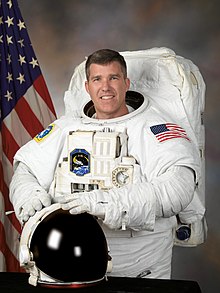Stephen Bowen (astronaut)
Steve Bowen | |
|---|---|
 Bowen in April 2008 | |
| Born | Stephen Gerard Bowen February 13, 1964 |
| Education | United States Naval Academy(BS) Massachusetts Institute of Technology(MS) |
| Space career | |
| NASA astronaut | |
| Rank | Captain,USN |
Time in space | 226d 8h 43m |
| Selection | NASA Group 18 (2000) |
TotalEVAs | 10 |
Total EVA time | 65h 57m |
| Missions | STS-126 STS-132 STS-133 SpaceX Crew-6(Expedition 68/69) |
Mission insignia | |
Stephen Gerard"Steve"Bowen(born February 13, 1964) is aUnited States Navysubmarinerand aNASAastronaut;he was the second submariner to travel into space. Bowen has been on fourspaceflights,the first three of which wereSpace Shuttlemissions to theInternational Space Station.His first mission,STS-126,took place in November 2008, and his second wasSTS-132in May 2010. His third wasSTS-133in February 2011, and his fourth wasSpaceX Crew-6in March 2023.
In March 2011, Bowen completed his third spaceflight as a mission specialist onSTS-133,which was Space ShuttleDiscovery's final planned flight. Having flown on both STS-132 and STS-133, he became the first and only astronaut to fly on consecutive shuttle missions. OriginallyTim Koprawas scheduled to fly on STS-133, but had a bicycle injury shortly before the mission, and so he was replaced by Bowen.[1]On December 16, 2021, NASA assigned Bowen as commander ofSpaceX Crew-6mission to the ISS, launched in March 2023.
Personal life and early education[edit]
Bowen resides inFriendswood, Texas.He is married to Deborah Alden; they have three children. He graduated fromCohasset High School,Cohasset, Massachusettsin 1982, received a B.S. inElectrical Engineeringfrom theUnited States Naval Academyin 1986 and received an M.S. inOcean Engineeringfrom theMassachusetts Institute of Technologyin 1993. He is a member ofTau Beta Pi,Phi Kappa PhiandSigma Pi Sigma.[2] In his spare time, Stephen Bowen has also had connections with the organisation ISSET, through him being the resident astronaut during a few of theirMission Discoveryprograms. Here he shares his experiences with students as well as try to teach them new skills and influence them to maybe follow a career in the sciences.[3]
Military career[edit]
Upon completion of the submarine training pipeline, Bowen spent three years attached toUSSParcheand completed qualification in submarines onUSSPogy.[2]After attending theMIT/WHOI Joint Programin Ocean Engineering he reported toUSSAugustafor duty as the Engineering Officer. During this tour, he qualified for command of nuclear powered submarines. In 1997, he reported to theUnited States Special Operations Command(USSOCOM) in the Office of Plans and Policy and worked on the USSOCOM Future Concepts Working Group. For nine months in 1999, he was the Reactor and Propulsion inspector for the Navy's Submarine Board of Inspection and Survey (INSURV). In May 2000 he became the first Executive Officer of the Pre-Commissioning UnitVirginia,the first of the newVirginia-classsubmarines.[2]
NASA career[edit]
Bowen is the first Submarine Officer selected by NASA.[2]He was selected as an astronaut candidate in July 2000, as one of NASA'sAstronaut Group 18.He reported for training at the Johnson Space Center in August 2000. Following the completion of two years of training and evaluation, he was initially assigned technical duties in the Astronaut Office Station Operations Branch while awaiting assignment to a Shuttle flight as amission specialist.[2]Bowen was originally assigned toSTS-124but was moved to a later flight to allow the Shuttle to rotate an ISS crew member.[4]

STS-126[edit]
Bowen was then assigned to the crew ofSTS-126,aboard Space ShuttleEndeavour,which launched November 14, 2008, to theInternational Space Station.STS-126 carried a reusable logistics module that held supplies and equipment, including additional crew quarters, exercise apparatus, equipment for the regenerative life support system, and spare hardware.
During STS-126, Bowen participated in threespacewalks,for a total time of 19 hours, 56 minutes.[5]
STS-132[edit]
Bowen's next mission wasSTS-132,aboard Space ShuttleAtlantis,which launched on May 14, 2010, to the ISS. While docked to the station, Bowen conducted two spacewalks and logged 14 hours and 34 minutes of EVA time.[2]
STS-133[edit]
On January 19, 2011, Bowen was named as the replacement forTimothy L. KopraonSTS-133.Kopra was injured in a bicycle accident, preventing him from flying on the mission. With this mission, Bowen became the first and only astronaut to fly on consecutive Shuttle missions.[1]George Nelsonwas the first astronaut to fly consecutive Space Shuttle missions in which the Shuttle landed successfully (STS-61-CandSTS-26), having theSpace ShuttleChallengerdisasterbetween his missions.[6]Bowen conducted two spacewalks and logged 12 hours and 48 minutes of EVA time.
SpaceX Crew-6[edit]
On December 16, 2021, Bowen was named Commander for NASA's SpaceX Crew-6. The flight lifted off on March 2, 2023, to theInternational Space StationusingCrew DragonEndeavour.
Awards and honors[edit]
References[edit]
- ^ab"NASA'S Shuttle Discovery Heads To Space Station On Its Final Mission".NASA. February 24, 2011.
- ^abcdef"Astronaut Bio: Stephen G. Bowen"(PDF).NASA. April 2021.RetrievedJuly 6,2021.
- ^"Mission Discovery gets ready to blast off".June 22, 2015.
- ^Withers, Stephen (2007)."Crew assignments for space shuttle mission STS-126 have been revised following the resignation of an experienced astronaut".iTWire. Archived fromthe originalon June 5, 2008.RetrievedNovember 22,2007.
- ^William Harwood for CBS News (November 24, 2008)."Spacewalk No. 4 ends".Spaceflightnow.com.RetrievedNovember 24,2008.
- ^"STS-133 launch remains on track as Bowen replaces the injured Kopra".nasaspaceflight.com. January 19, 2011.RetrievedJanuary 19,2011.
External links[edit]
- 1964 births
- Living people
- United States Navy astronauts
- People from Cohasset, Massachusetts
- United States Naval Academy alumni
- MIT School of Engineering alumni
- United States Navy officers
- United States submarine commanders
- Space Shuttle program astronauts
- Cohasset High School alumni
- Crew members of the International Space Station
- Spacewalkers
- Military personnel from Massachusetts
- SpaceX astronauts
